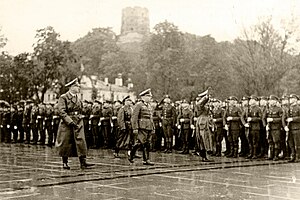| Lithuanian Auxiliary Police | |
|---|---|
| Litauische Hilfspolizei | |
 Lithuanian Schutzmannschaft standing in formation in Vilnius Cathedral Square | |
| Active | July 9, 1941 - May 1945 |
| Country | |
| Type | Schutzmannschaft |
| Operations jurisdiction | |
| Commanders | |
| Notable commanders |
|
The Lithuanian Auxiliary Police was a Schutzmannschaft formation formed during the German occupation of Lithuania between 1941 and 1944, with the first battalions originating from the most reliable freedom fighters, disbanded following the 1941 anti-Soviet Lithuanian June Uprising in 1941.[3] Lithuanian activists hoped that these units would be the basis of a reestablished Lithuanian Army commanded by the Lithuanian Provisional Government.[4] Instead, they were put under the orders of the SS- und Polizeiführer in Lithuania.[5]
Lithuanian auxiliary policemen were divided into four types. The first three were: regular law enforcement policemen, firefighting policemen, and auxiliary units grouped into platoons that assisted the local police when needed.[2] The last were Lithuanian Schutzmannschaft battalions, closed formations organized into battalions, companies, platoons and groups.[2]
The battalions were charged with internal security duties and engaged in anti-partisan operations in the Wehrmacht's rear areas, e.g. Ukraine, Belarus, Poland and Northwest Russia.[6] Some battalions took part in the Holocaust, most notably the 12th and the 13th battalions, which started as the Lithuanian TDA Battalions. These two battalions were responsible for an estimated 78,000 Jewish deaths in Lithuania and Belarus.[citation needed] While the battalions were often deployed outside Lithuania, they generally did not participate in combat. In total, 26 battalions were formed and approximately 20,000[7] men served in them.[8] In July to September 1944, the remaining units were combined into two Lithuanian Volunteer Infantry Regiments[9]
- ^ Bubnys 2017, p. 151-152.
- ^ a b c d e f Bubnys 2017, p. 152.
- ^ Mollo 1992, p. 26.
- ^ Caballero 2002, p. 35.
- ^ Arad 1990, p. 1176.
- ^ Caballero 2002, pp. 35–37.
- ^ "policijos batalionai". www.vle.lt (in Lithuanian). Retrieved 2023-09-03.
- ^ Anušauskas, et al. (2005), p. 232
- ^ Stoliarovas (2008a), p. 16